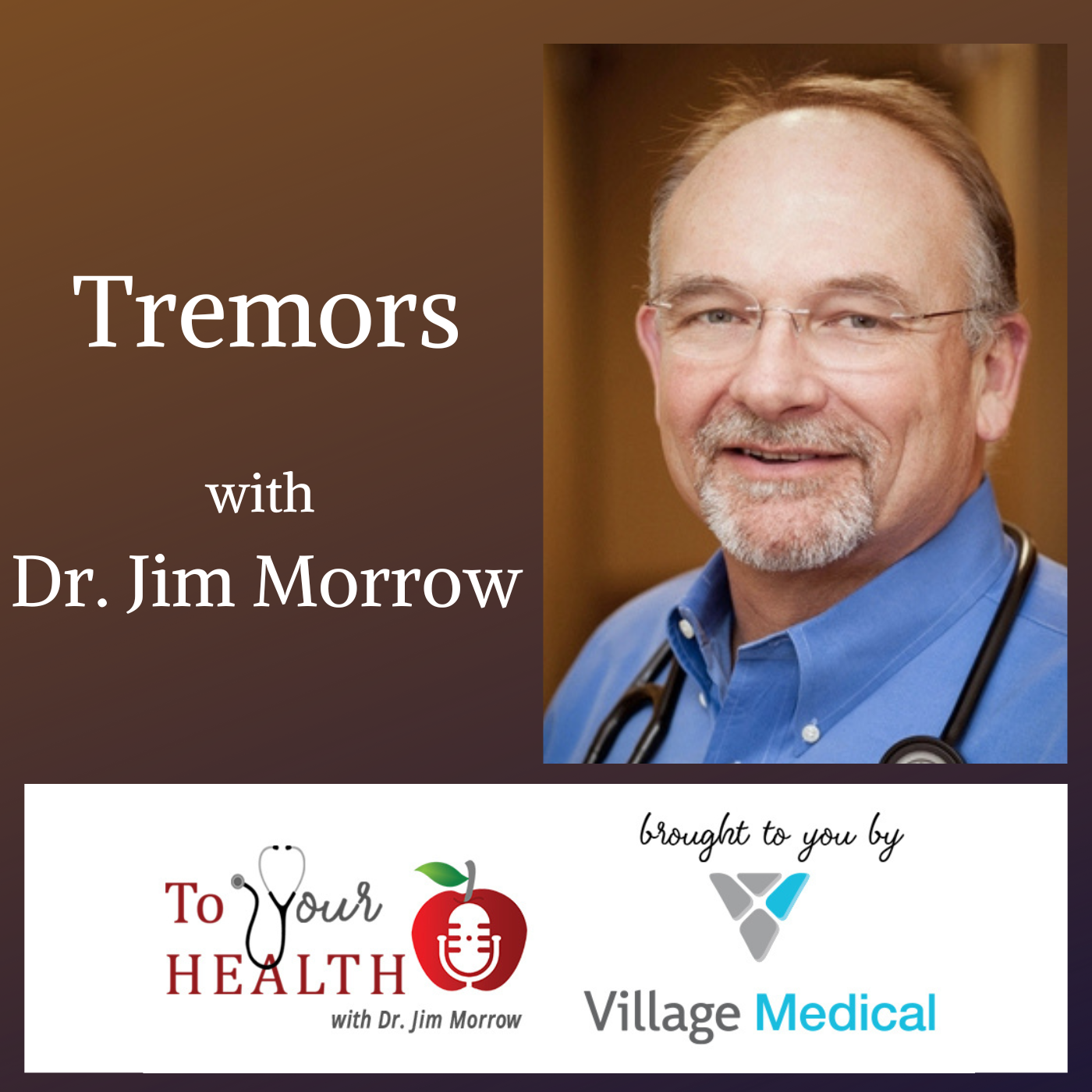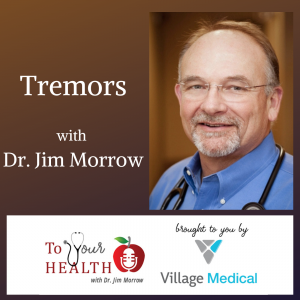
Tremors (Episode 90, To Your Health with Dr. Jim Morrow)
On this episode of To Your Health, Dr. Jim Morrow covers tremors, the difference between benign essential tremors and Parkinson’s Disease, how they are diagnosed, potential causes, what the doctor might do for treatment, and much more.
To Your Health is brought to you by Village Medical (formerly Morrow Family Medicine), which brings the care back to healthcare.
About Village Medical (formerly Morrow Family Medicine)
Village Medical, formerly Morrow Family Medicine, is an award-winning, state-of-the-art family practice with offices in Cumming and Milton, Georgia. The practice combines healthcare information technology with old-fashioned care to provide the type of care that many are in search of today. Two physicians, three physician assistants and two nurse practitioners are supported by a knowledgeable and friendly staff to make your visit to Village Medical one that will remind you of the way healthcare should be. At Village Medical, we like to say we are “bringing the care back to healthcare!” The practice has been named the “Best of Forsyth” in Family Medicine in all five years of the award, is a three-time consecutive winner of the “Best of North Atlanta” by readers of Appen Media, and the 2019 winner of “Best of Life” in North Fulton County.
Village Medical offers a comprehensive suite of primary care services including preventative care, treatment for illness and injury, and management of chronic conditions such as diabetes, congestive heart failure, chronic obstructive pulmonary disease (COPD) and kidney disease. Atlanta-area patients can learn more about the practice here.
Dr. Jim Morrow, Village Medical, and Host of To Your Health with Dr. Jim Morrow
 Dr. Jim Morrow is the founder of Morrow Family Medicine. He has been a trailblazer and evangelist in healthcare information technology, was named Physician IT Leader of the Year by HIMSS, a HIMSS Davies Award Winner, the Cumming-Forsyth Chamber of Commerce Steve Bloom Award Winner as Entrepreneur of the Year and he received a Phoenix Award as Community Leader of the Year from the Metro Atlanta Chamber of Commerce. He is married to Peggie Morrow and together they founded the Forsyth BYOT Benefit, a charity in Forsyth County to support students in need of technology and devices. They have two Goldendoodles, a gaggle of grandchildren and enjoy life on and around Lake Lanier.
Dr. Jim Morrow is the founder of Morrow Family Medicine. He has been a trailblazer and evangelist in healthcare information technology, was named Physician IT Leader of the Year by HIMSS, a HIMSS Davies Award Winner, the Cumming-Forsyth Chamber of Commerce Steve Bloom Award Winner as Entrepreneur of the Year and he received a Phoenix Award as Community Leader of the Year from the Metro Atlanta Chamber of Commerce. He is married to Peggie Morrow and together they founded the Forsyth BYOT Benefit, a charity in Forsyth County to support students in need of technology and devices. They have two Goldendoodles, a gaggle of grandchildren and enjoy life on and around Lake Lanier.
The complete show archive of To Your Health with Dr. Jim Morrow addresses a wide range of health and wellness topics.
Dr. Morrow’s Show Notes
Types of Tremors
- Essential tremor (ET) is at least eight times more common than Parkinson’s disease (PD).
- There are many differences in the presentation, course, and treatment of ET and PD;
- however, these differences are not always recognized by healthcare professionals and misdiagnoses are common
- it has been suggested that up to 20 percent of patients with ET may develop PD,
- but whether ET is a risk factor for PD remains a controversial issue
Diagnosis
- At this time, there are no tests that can definitively diagnose either ET or PD and it is not uncommon to have the two mistaken for each other.
- The diagnosis is based on a complete medical/symptom, family and medication history and an examination by a physician,
- Obtaining a handwriting sample may be helpful in making an accurate diagnosis;
- in ET handwriting is generally large and tremulous,
- whereas in PD, micrographia (very small handwriting) is common.
- DaTscan, a single photon emission computed tomography (SPECT) scan,
- which measures dopamine uptake, has been approved as a diagnostic aid to help physicians differentiate between ET and parkinsonian tremor.
- Other imaging techniques are under investigation to determine their utility in differentiating ET and PD.
- An accurate diagnosis is critical as the treatment regimen is very different for the two disorders.
Differentiating ET and PD
- Usually ET starts as a low- amplitude tremor but can gradually increase to a coarse, disabling tremor.
- As ET progresses, tremor frequency (number of repetitions per second) may decrease;
- however, tremor amplitude (magnitude/strength) may increase.
- Increased amplitude is associated with a decreased ability to manage fine motor tasks.
- The amplitude varies up to 23 percent throughout the day, but the frequency usually does not change during the course of the disease.2
- ET generally presents bilaterally and is primarily seen during action,
- such as when writing or eating, or when holding a posture, for example, when holding an object against gravity.
- On the other hand, parkinsonian tremor most often presents unilaterally and later progresses to include both sides of the body.
- PD tremor most commonly occurs at rest,
- when the body part is relaxed and not in use,
- but can also be seen in the postural position, often referred to as reemergent tremor.3
- ET most commonly affects the
- hands, legs, head, and voice, and tremor is the primary symptom of ET.
- In PD, the cardinal symptoms include bradykinesia, rigidity, tremor, and gait/balance issues.
- It is important to note that although it occurs in the majority, tremor does not have to be present to make a diagnosis of PD.
- The tremor of PD most generally occurs in the upper/lower extremities and the chin/jaw and generally does not affect the head or voice.
- ET most commonly onsets during middle age,
- but can occur at any time in the lifespan, even in childhood.
- The progression of ET can be variable.
- In some patients ET remains mild throughout the lifespan and does not result in significant disability;
- however, in others ET progresses and can cause significant disability,
- making many daily activities very difficult or impossible to complete.
- On the other hand, the average age of onset of PD is 60 years although it may be much later and about 10 percent present prior to the age of 40 years.
- PD is a progressive disorder with virtually all patients having increased disability over time.
- Although the gene accounting for the majority of ET patients has not been identified,
- ET is an autosomal dominant disorder with greater than 50 percent of patients reporting a family history of tremor.
- It is not uncommon to have a patient report multiple family members from several generations that have been affected by tremor.
- PD is the result of a loss of dopamine in the substantia nigra;
- however, the cause of PD is currently unknown and it is suspected that it may be a combination of a genetic predisposition and environmental influences.
- A family history of PD is reported in less than 20 percent of patients.
- Both ET and PD are affected by stress, anxiety and emotion and it is not uncommon to see an increase in tremor under stressful conditions.
- ET is an autosomal dominant disorder with greater than 50 percent of patients reporting a family history of tremor.
- however, in others ET progresses and can cause significant disability,
- As ET progresses, tremor frequency (number of repetitions per second) may decrease;
What is essential tremor?
- So, there different kinds of tremor…
- Many things can cause tremor.
- Not all tremors are essential tremors.
- For example,
- Parkinson’s disease causes tremor that you might notice when your hands are resting in your lap or at the sides of your body.
- A stroke can cause tremor that gets worse when you reach for something.
- Thyroid problems or low blood sugar can cause mild tremor.
- Tremor can be caused by some medicines.
- These include
- heart medicines,
- decongestants,
- medicines for breathing problems,
- and tricyclic antidepressants.
- Drinks that contain caffeine also may cause a tremor.
- These include
How is essential tremor diagnosed?
- Your doctor will probably perform an exam
- and tests to look for possible causes of your tremor.
- These tests rule out other causes and can include
- a neurological exam,
- blood and urine tests,
- and physical performance tests.
- If they don’t find another cause of your tremor,
- you may be diagnosed with essential tremor.
- There is no specific test for essential tremor.
Can essential tremor be prevented or avoided?
- Doctors don’t know exactly what causes essential tremor,
- so, it can’t be prevented.
- If your doctor determines your tremor is caused by medicine or caffeine,
- you may be able to avoid essential tremor in the future by avoiding those substances.
Essential tremor treatment
- The goal in treating essential tremor is to provide symptom relief that can improve quality of life.
- Mild tremors may not need treatment.
- If your essential tremor interferes with your ability to function or bothers you,
- there are some treatments that could help.
- These include medicine, focused ultrasound, or deep brain stimulation.
- Medicine–
- Your doctor might suggest oral medicines to help decrease the severity of your tremor.
- These could include
- beta blockers,
- anti-seizure medicines,
- tranquilizers,
- or Botox injections.
- Therapy–
- Physical therapy can help you improve your muscle strength, control, and coordination.
- Occupational therapy can help you make modifications to reduce the effects of tremors,
- such as using heavier glasses to drink out of.
- Surgery–
- If your tremor is very disabling and you haven’t had good results with medicine,
- you could qualify for surgery.
- Usually this is deep brain stimulation (DBS).
- Electrodes are implanted into the area of your brain that coordinates muscle control
- If your tremor is very disabling and you haven’t had good results with medicine,
- Medicine–
Living with essential tremor
- Lifestyle changes are often recommended to prevent the tremor from getting worse.
- Your doctor will ask you to avoid caffeine, cold medicines, and certain other medicines if they seem to make your tremor worse.
- These medicines won’t make your tremor go away.
- However, the medicine may control the tremor enough to allow you to do normal activities without frustration or embarrassment.
- Symptoms do tend to get worse over time.
- Eventually you might start having trouble with daily functions, including
- Holding a glass of liquid without spilling
- Eating normally
- Putting on makeup or shaving
- Talking, if it affects your tongue or voice box
- Eventually you might start having trouble with daily functions, including















